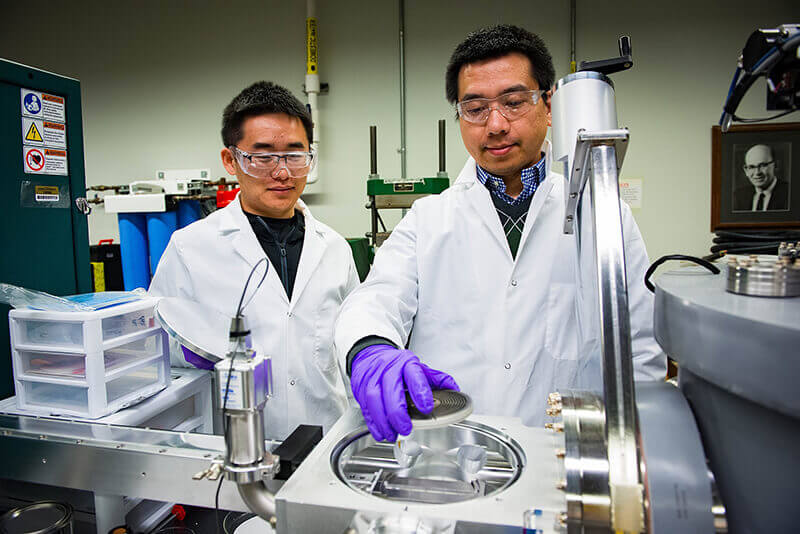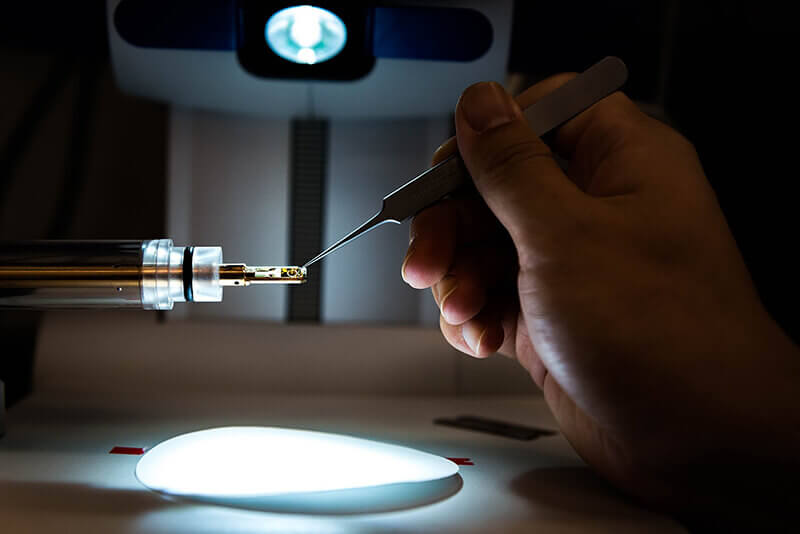January 25, 2018
New research yields super-strong aluminum alloy
WEST LAFAYETTE, Ind. – Researchers have demonstrated how to create a super-strong aluminum alloy that rivals the strength of stainless steel, an advance with potential industrial applications.
“Most lightweight aluminum alloys are soft and have inherently low mechanical strength, which hinders more widespread industrial application,” said Xinghang Zhang, a professor in Purdue University’s School of Materials Engineering. “However, high-strength, lightweight aluminum alloys with strength comparable to stainless steels would revolutionize the automobile and aerospace industries.”
New research shows how to alter the microstructure of aluminum to impart greater strength and ductility. Findings were detailed in two new research papers. The work was led by a team of researchers that included Purdue postdoctoral research associate Sichuang Xue and doctoral student Qiang Li.
The most recent paper was published online Jan. 22 in the journal Advanced Materials. The earlier paper was published in November in the journal Nature Communications.
The new high-strength aluminum is made possible by introducing “stacking faults,” or distortions in the crystal structure. While these are easy to produce in metals such as copper and silver, they are difficult to introduce in aluminum because of its high “stacking fault energy.”
A metal’s crystal lattice is made up of a repeating sequence of atomic layers. If one layer is missing, there is said to be a stacking fault. Meanwhile, so-called “twin boundaries” consisting of two layers of stacking faults can form. One type of stacking fault, called a 9R phase, is particularly promising, Zhang said.
 Purdue postdoctoral research associate Sichuang Xue, at left, and doctoral student Qiang Li, prepare a sample for research to create super-strong aluminum alloys. (Purdue University image/Marshall Farthing)
Download image
Purdue postdoctoral research associate Sichuang Xue, at left, and doctoral student Qiang Li, prepare a sample for research to create super-strong aluminum alloys. (Purdue University image/Marshall Farthing)
Download image
“It has been shown that twin boundaries are difficult to be introduced into aluminum. The formation of the 9R phase in aluminum is even more difficult because of its high stacking fault energy,” Zhang said. “You want to introduce both nanotwins and 9R phase in nanograined aluminum to increase strength and ductility and improve thermal stability.” (A YouTube video is available at https://youtu.be/Y3dYq-N4xSY)
Now, researchers have learned how to readily achieve this 9R phase and nanotwins in aluminum.
“These results show how to fabricate aluminum alloys that are comparable to, or even stronger than, stainless steels,” he said. “There is a lot of potential commercial impact in this finding.”
Xue is lead author of the Nature Communications paper, which is the first to report a “shock-induced” 9R phase in aluminum. Researchers bombarded ultrathin aluminum films with tiny micro-projectiles of silicon dioxide, yielding 9R phase.
“Here, by using a laser-induced projectile impact testing technique, we discover a deformation-induced 9R phase with tens of nanometers in width,” Xue said.
The microprojectile tests were performed by a research group at Rice University, led by professor Edwin L. Thomas, a co-author of the Nature Communications paper. A laser beam causes the particles to be ejected at a velocity of 600 meters per second. The procedure dramatically accelerates screening tests of various alloys for impact-resistance applications.
“Say I want to screen many materials within a short time,” Zhang said. “This method allows us to do that at far lower cost than otherwise possible.”
Li is lead author of the Advanced Materials paper, which describes how to induce a 9R phase in aluminum not by shock but by introducing iron atoms into aluminum’s crystal structure via a procedure called magnetron sputtering. Iron also can be introduced into aluminum using other techniques, such as casting, and the new finding could potentially be scaled up for industrial applications.
The resulting “nanotwinned” aluminum-iron alloy coatings proved to be one of the strongest aluminum alloys ever created, comparable to high-strength steels.
“Molecular-dynamics simulations, performed by professor Jian Wang’s group at the University of Nebraska, Lincoln, showed the 9R phase and nanograins result in high strength and work-hardening ability and revealed the formation mechanisms of the 9R phase in aluminum,” Zhang said. “Understand new deformation mechanisms will help us design new high strength, ductile metallic materials, such as aluminum alloys.”
 A sample is readied for analysis using a transmission electron microscope. (Purdue University image/Marshall Farthing)
Download image
A sample is readied for analysis using a transmission electron microscope. (Purdue University image/Marshall Farthing)
Download image
One potential application might be to design wear- and corrosion-resistant aluminum alloy coatings for the electronics and automobile industries.
The research was mainly funded by U.S. Department of Energy’s Office of Basic Energy Sciences, Materials Science and Engineering Division. The researchers have filed a patent application through the Purdue Research Foundation’s Office of Technology Commercialization.
The transmission electron microscopy work for the research was supported by a new FEI Talos 200X microscope facility directed by Haiyan Wang, Purdue’s Basil S. Turner Professor of Engineering; and the “in situ micropillar compression” work in scanning electron microscopes was supported by Purdue’s Life Science Microscopy Facility, led by Christopher J. Gilpin, director of the facility. These advanced microscopy facilities were made possible with support from Purdue’s Office of the Executive Vice President for Research and Partnerships.
The team included researchers from Purdue’s School of Materials Engineering, Department of Materials Science and NanoEngineering at Rice University, the Department of Engineering Physics at the University of Wisconsin-Madison, State Key Lab of Metal Matrix Composites, the School of Materials Science and Engineering at Shanghai Jiao Tong University, Department of Materials Science and Engineering at China University of Petroleum, California Institute of Technology, Louisiana State University and the University of Nebraska-Lincoln. A complete listing of co-authors is available in the abstracts.
Writer: Emil Venere, 765-494-4709, venere@purdue.edu
Source: Xinghang Zhang, 765-494-1641, xzhang98@purdue.edu
Note to Journalists: The research paper is available at https://doi.org/10.1002/adma.201704629 or from Emil Venere, Purdue University News Service, 765-494-4709. venere@purdue.edu. A YouTube video is available at https://youtu.be/Y3dYq-N4xSY, and other materials are accessible on Google Drive at https://goo.gl/Wob14Q. The video was produced by Erin Easterling, Purdue College of Engineering digital producer, 765-496-3388, Easterling@purdue.edu
ABSTRACT
High-velocity projectile impact induced 9R phase in ultrafine-grained aluminium
Sichuang Xue1, Zhe Fan1, Olawale B. Lawal2, Ramathasan Thevamaran 2,3, Qiang Li1, Jian Wang6, Edwin L. Thomas2, Haiyan Wang 1 & Xinghang Zhang 1
1School of Materials Engineering, Purdue University, West Lafayette, IN 47907, USA. 2Department of Materials Science and NanoEngineering, Rice University, Houston, TX 77005, USA. 3Department of Engineering Physics, University of Wisconsin-Madison, Madison, WI 53706, USA. 4State Key Lab of Metal Matrix Composites, School of Materials Science and Engineering, Shanghai Jiao Tong Univeristy, Shanghai 200240, China. 5Department of Materials Science and Engineering, China University of Petroleum, Beijing 102249, China. 6Mechanical and Materials Engineering, University of Nebraska-Lincoln, Lincoln, NE 68588, USA. Correspondence and requests for materials should be addressed to J.W. (email: jianwang@unl.edu) or to X.Z. (email: xzhang98@purdue.edu)
Aluminum typically deforms via full dislocations due to its high stacking fault energy. Twinning in aluminum, although difficult, may occur at low temperature and high strain rate. However, the 9R phase rarely occurs in aluminum simply because of its giant stacking fault energy. Here, by using a laser-induced projectile impact testing technique, we discover a deformation-induced 9R phase with tens of nm in width in ultrafine-grained aluminum with an average grain size of 140 nm, as confirmed by extensive post-impact microscopy analyses. The stability of the 9R phase is related to the existence of sessile Frank loops. Molecular dynamics simulations reveal the formation mechanisms of the 9R phase in aluminum. This study sheds lights on a deformation mechanism in metals with high stacking fault energies.
ABSTRACT
High-strength nanotwinned Al alloys with 9R phase
Qiang Li, Sichuang Xue, Jian Wang, Shuai Shao, Anthony H. Kwong, Adenike Giwa, Zhe
Fan, Yue Liu, Zhimin Qi, Jie Ding, Han Wang, Julia R. Greer, Haiyan Wang and Xinghang Zhang*
Q. Li, S. Xue, Z. Qi, J. Ding, H. Wang, Prof. H. Wang, Prof. X. Zhang: School of Materials Engineering, Purdue University, Email: xzhang98@purdue.edu
Prof. J. Wang: Mechanical and Materials Engineering, University of Nebraska-Libncoln
Prof. S. Shao: Mechanical and Industrial Engineering, Louisiana State University
Z. Fan: Oak Ridge National Laboratory
Prof. Y. Liu: State Key Lab of Metal Matrix Composites, School of Materials Science and Engineering, Shanghai Jiao Tong University
A.H. Kwong, A. Giwa, prof. J.R. Greer: Division of Engineering and Applied Science, California Institute of Technology
Lightweight AL alloys have widespread applications. However, most AL alloys have inherently low mechanical strength. Nanotwins can induce high strength and ductility in metallic materials. Yet, introducing high-density growth twins into AL remains difficult due to its ultra-high stacking fault energy (SFE). In this study, we show that incorporating merely several atomic percent of Fe solutes into AL enables the formation of nanotwinned (nt) columnar grains with high-density 9R phase in Al(Fe) solid solutions. The nt Al-Fe alloy coatings reach a maximum hardness of ~ 5.5 GPa, one of the strongest binary Al alloys ever created. In situ uniaxial compressions show that the nt Al-Fe alloys populated with 9R phase have flow stress exceeding 1.5 GPa, comparable to high-strength steels. Molecular dynamics simulations reveal that high-strength and hardening ability of Al-Fe alloys arise mainly from the high-density 9R phase and nanoscale grain size.

